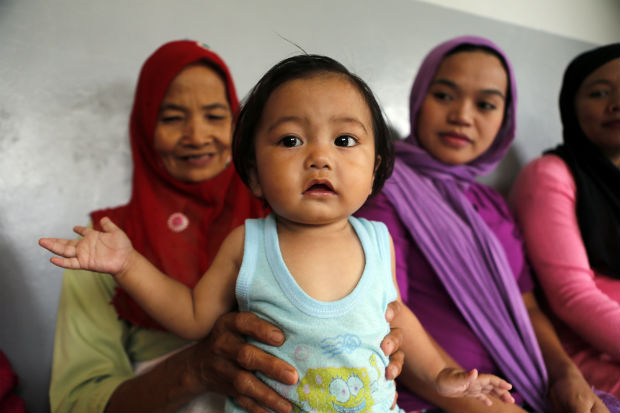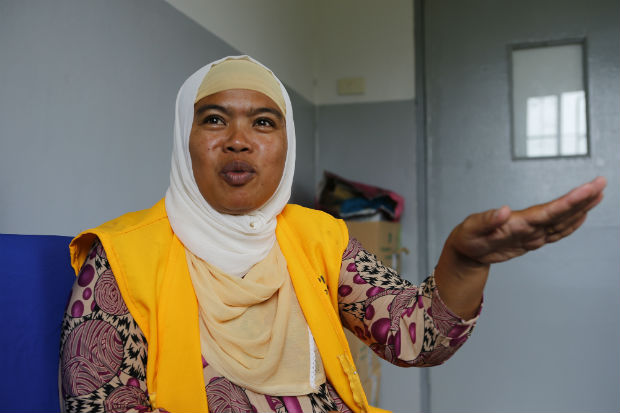Reaching malnourished children in remote communities of Lanao del Sur

Hasmina Saidamen, 1, who is undergoing therapeutic treatment for severe acute malnutrition, is held by her grandmother inside the health center in Sultan Dumalondong, Lanao del Sur. ©UNICEF PHILIPPINES
A two-hour ride from the bustling city of Marawi lies Sultan Dumalondong. This remote town of Lanao del Sur in the Autonomous Region of Muslim Mindanao (ARMM), boasts of a perennial cool weather which lends it an almost idyllic rural ambiance.
Yet the charm belies the town’s violent history of rido or clan war that has invariably brought suffering to families in this town.
Trapped in a vicious cycle of violence, Sultan Dumalondong and its outlying barangays remain in relative isolation and remain underdeveloped.
Access to most of its seven barangays is difficult. There are no roads, only trails. When it rains, it becomes extremely difficult, especially for those needing emergency medical attention.
With poor accessibility and security issues, access to basic services such as health and education remains a major challenge.
Challenging traditional beliefs
In one of these remote barangays, Sittie “Pek” Kurangking, a Barangay Health Worker (BHW) found one year old Hasmina in an elderly woman’s home in January, while doing her rounds to screen children for malnutrition.
Pek didn’t need the red marker on the MUAC or mid-upper arm circumference tape, a color-coded tape to measure the degree of thinness, to know that baby Hasmina was severely malnourished. She has all the tell-tale signs– extremely thin arms and legs, sunken eyes, and a body covered in rashes.
She advised Pulabi, the 60-year-old grandmother, to bring the baby to the clinic but was appalled when the grandmother refused.
“She wouldn’t listen when I told her that the baby is seriously ill and needed to be seen immediately by the doctor at the rural health clinic,” she says.
Pek went back several times to convince the grandmother. In the course of her visit, she found that Pulabi has been taking care of Hasmina since her parents separated. The baby is left with her while her son works. With her limited resources, Pulabi fed Hasmina with sugared water. Milk is a luxury she couldn’t afford. The lack of nutrients is evident in her frail body.
On the seventh visit, Pulabi finally relented. A check-up confirmed that Hasmina was suffering from severe acute malnutrition (SAM). At six months, she didn’t have any vaccinations. Her grandmother believed that vaccines will make the baby ill.
A grim picture
ARMM has consistently been one of the regions in the Philippines with the highest prevalence of undernutrition.
According to the 2013 Food and Nutrition Research Institute – National Nutrition Survey (FNRI-NNS), close to 12,000 children in ARMM have 9 times more likelihood of dying because of Severe Acute Malnutrition (SAM). Around 4 out of every 10 children are unable to reach their optimal height for their age because of chronic undernutrition.
Both acute and chronic form of undernutrition have serious impediments on survival and growth in early years of life, learning outcomes during school age, productivity as adults and economy of the country. The situation of undernutrition is even worse in the island provinces and far-flung areas in ARMM.
The right to adequate nutrition is a fundamental right for children. While it is a known fact that exclusive breastfeeding (feeding babies with only mother’s milk for the first six months of life) is still the best way to prevent malnutrition, the 2013 Philippine National Demographics and Health Survey (NDHS) reveals that 6 in 10 (60.3%) newborns in ARMM were given food or liquids other than breastmilk before initiating breastfeeding. These feeds are less nutritious, more susceptible to contamination and may reduce mother’s breastmilk flow and discourage mother from breastfeeding her baby.
The same survey shows that micronutrient deficiencies affect large parts of the population in ARMM, with 4 in 10 under 5 year-olds not receiving Vitamin A supplements, 7 in 10 have not been dewormed and 8 in 10 have had no access to iron supplementation. Only 1 in 10 pregnant women is able to complete the 90-day recommended iron and folic acid supplementation.
A number of factors contribute to the problem of malnutrition in the ARMM. Among them is the lack of awareness about malnutrition and the programs to manage and prevent it especially during the critical 1000 days of child life-time from when she is conceived till her 2nd birthday. This is further aggravated by traditional beliefs and misconceptions towards breastfeeding and vaccination.
“The remoteness of the communities and the security issues in the area also make access and delivery of health services difficult,” says Dr. Rosalia Bataclan, UNICEF’s Health and Nutrition Specialist.
Reaching the most vulnerable
To address high malnutrition rates in the ARMM, UNICEF is implementing a nutrition program in the region which aims to improve the well-being and survival of children under the age of 5 with special focus on improving nutrition service delivery during the first 1,000 days of a child’s life. This involves delivering cost-effective life-saving nutrition and health services to children through Infant and Young Child Feeding (IYCF) counseling for pregnant and lactating women and caregivers. Treatment of (SAM) is also made available at the Rural Health Unit (RHU) using standardized therapeutic nutrition and medical protocols, including Ready-to-Use Therapeutic Food (RUTF), and the provision of Micronutrient Supplementation to children and pregnant women.
From January to June this year, 483 government health workers in the pilot areas in ARMM have been trained on Community-based Management of Acute Malnutrition (CMAM).
With their training, they were able to screen more than 45,000 under 5 year-old children for acute malnutrition. They found 643 children suffering from SAM, who were then enrolled into the appropriate life-saving therapeutic care. To date, 182 have already been cured and are enrolled for routine health care services.
In Sultan Dumalondong, UNICEF in partnership with the Health Organization of Mindanao (HOM) and the Lanao del Sur Provincial Health Office screened 1,270 under 5 year old children so far out of the 10,500 children living there. Hasmina was one of the five cases found in the municipality to be suffering from Severe Acute Malnutrition (SAM) who were enrolled in the treatment program and were provided lifesaving treatment and care. Still many children are difficult to reach because of the security and topography of four isolated barangays in the municipality.
Empowering nutrition champions
Barangay Health Workers (BHW) like Pek are tough allies in this fight against malnutrition. UNICEF invests in training them to build their capacity to treat and follow up cases of SAM, and perform nutrition counseling to successfully manage malnutrition cases.
To further ensure the success of the program, communities are encouraged to take charge of their community’s nutrition efforts by organizing mothers and caregivers to counsel their neighbors.
Since Hasmina was enrolled in the treatment program, she has shown a lot of improvement and is now on her way to achieving her healthy green reading on the MUAC tape. Pek has been monitoring her condition and has religiously followed up her treatment.
“It’s a tough job being a BHW but I am happy with the work that I do. It makes me really happy when I see that I have made a difference in a mother or a child’s life,” says Pek. Karen Rivera, UNICEF.

Sittie Conaifah Kurangking (above) is one of the barangay health workers trained by UNICEF to monitor the nutritional status of children in Sultan Dumalondong. ©UNICEF PHILIPPINES